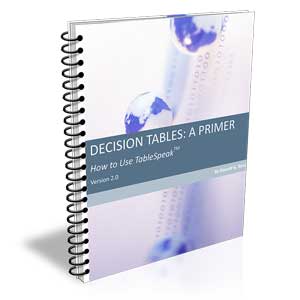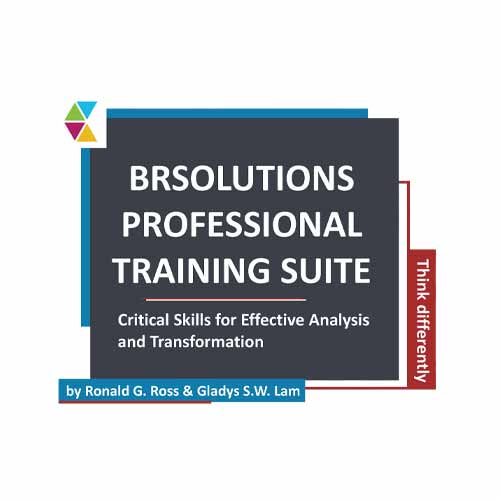What's the Business in Business Rules?
Not all rules are 'business' rules. If rules are about the logical design of the system, then they're 'system design' rules (Zachman Framework Row 3, as applied to knowledge/information systems). If they're rules required to deal with a specific information technology, then they are 'technology' rules (ZF Row 4). If rules are specific to a particular vendor's implementation of a technology, then they are 'vendor specific' rules (ZF Row 5). Only rules about business activities whose content & purpose are independent of the knowledge/information system that will enforce them should be called 'business' rules. Here's why.
Let's start by defining what we mean when we say 'business.' The term 'business,' in its core sense, means "a person's regular occupation, profession, or trade."[1] It is used to refer to any kind of organized, purposeful human work activity. In context of knowledge/information systems we use 'business' to refer to work activity required to supply an organization's products/services and manage its resources, and specifically exclude all work activity involved in designing and building the knowledge/information system. In a sense, we are viewing the design and construction of knowledge/information systems as a separate enterprise.
There are three possible bases for labeling a rule a 'business' rule: its Content & Purpose, Terms of Expression, or Syntax. Each of these is a different way to categorize terms, facts, and rules with respect to the Perspectives (Rows) of the Zachman Framework. We can understand the difference between these key concepts by looking at how they are different at Rows 2, 3, 4, & 5 of the Zachman Framework, as applied to knowledge/information systems.
1) Content & Purpose: "What is the term, fact, or rule talking about?" Is its definition or statement talking about:
- something the business has to deal with (without making any reference to manual or automated information systems)?
- the logical design of the knowledge/information system?
- a particular information technology used?
- a specific vendor product?"
Why does it exist? Is it there to provide guidance for the way:
- the business deals with its customers, suppliers, etc., supplies its products and services; and manages its resources?
- the logical design of the information system deals with the laws of nature?
- the physical design of the information system deals with the technology chosen?
- a specific vendor product will be used to implement the physical design?
2) Terms of Expression: What is the term definition, fact statement, or rule statement expressed 'in terms of'? Is it expressed in terms:
- used in the business by business people when they talk and write about the business?
- that comprise the logical constructs in the logical system design, e.g., network node, class (logical), actor, interaction, behaviour, component (logical)?
- used only with the particular information technology, e.g., relational technology: table, foreign key, column?
- that are specific to a particular vendor's product?"
3). Syntax: What system of symbols and their arrangement is used to express the term definition, fact statement, or rule statement? Is the syntax with which it is expressed designed for use by:
- business people and their business tools, e.g., Word, Excel, PowerPoint, Visio, accounting, business forms, business reports, RuleTrack™?
- logical system designers and their logical design tools?
- technology system designers and their technology-specific tools?
- programmers using vendor-specific software tools?
The challenge is whether the 'business' in 'business rule' refers to the content & purpose, the terms of expression, or the syntax. The answers lies in whether the primary identity of a rule (or anything else) is in its form or in its substance (essence). Good names gather up the essence of the thing they are naming. The essence of a thing is in its content and purpose, not in its form.
Therefore, unless otherwise qualified, 'business rule' should refer to the core substance of the rule, which it is content & purpose. In other words, unless otherwise qualified, 'Business Rule' should be taken to mean a rule whose content is about and purpose is for the business (organized, purposeful human work activity) regardless of the terms in which it is expressed, or the syntax with which it is expressed.
We hear a lot of talk about syntax. But, interestingly, it is the different 'terms in which the rules are expressed' in the different Perspectives of the Zachman Framework (Rows) that is the source of most of the transformations and mapping between Rows -- not the different syntax with which they are expressed. Within the terms of a given Perspective (ZF Row) different syntaxes are surface expression differences that are easily translatable from one to another without transformations.
Furthermore, the typical heavy focus on syntax that ignores the 'terms in which the rules are expressed' hides the differences in meaning between the different Perspectives (ZF Rows). This leads to all sorts of communication and design problems.
Table 1. Rule Content vs. Rule Terms vs. Rule Syntax. (Also true for Terms & Facts)
References
[1] New Oxford Dictionary of English (Contemporary Usage).
![]()
# # #
About our Contributor:
Online Interactive Training Series
In response to a great many requests, Business Rule Solutions now offers at-a-distance learning options. No travel, no backlogs, no hassles. Same great instructors, but with schedules, content and pricing designed to meet the special needs of busy professionals.












